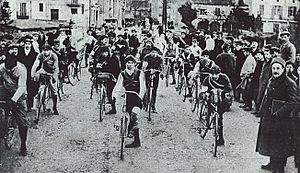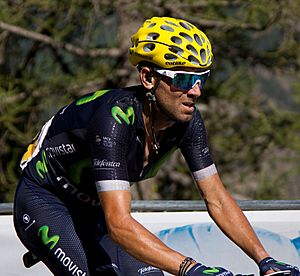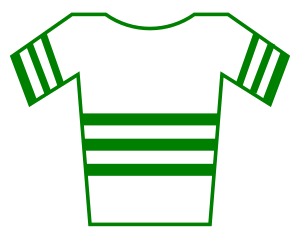Volta a Catalunya facts for kids
| Logotip Volta Ciclista a Catalunya.png | |
| Race details | |
|---|---|
| Date | Late March (men's race) Early June (women's race) |
| Region | Catalonia, Spain |
| English name | Tour of Catalonia |
| Local name(s) | Vuelta a Cataluña
Volta a Catalunya |
| Discipline | Road |
| Competition | UCI World Tour |
| Type | Major one week stage race |
| Organiser | "Volta" Ciclista a Catalunya Associació Esportiva (Unió Esportiva de Sants) |
| Race director | Rubèn Peris |
| History | |
| First edition | 1911 |
| Editions | 104 (as of 2025) |
| First winner | |
| Most wins | |
| Most recent | |
The Volta a Catalunya is a famous bicycle race held every year in Catalonia, Spain. Its name means "Tour of Catalonia" in English. It's one of the most important week-long bike races in the world.
This race is one of three big cycling events in Spain that are part of the UCI World Tour. The others are the Vuelta a España and the Tour of the Basque Country. The Volta a Catalunya usually takes place in late March.
The race lasts for seven days. It covers different parts of Catalonia in Northeast Spain. Riders often face tough stages in the Pyrenees mountains. The race traditionally ends in Barcelona, the capital of Catalonia. The final stage includes a challenging climb up Montjuïc.
The Volta a Catalunya started in 1911. This makes it the fourth-oldest bike race that is still happening today. Only the Tour de France (1903), the Tour of Belgium (1908), and the Giro d'Italia (1909) are older. A Spanish cycling hero, Mariano Cañardo, won the race seven times. This record has never been beaten.
Since 2024, there has also been a women's stage race. It is called the Volta Ciclista a Catalunya Femenina.
Contents
History of the Race
How it Started
The Volta a Catalunya was created in 1911. A sports journalist named Miquel Arteman came up with the idea. He worked for a newspaper in Barcelona called El Mundo Deportivo. He teamed up with Narcisse Masferrer and Jaume Grau to make the race happen.

The very first race was held from January 6 to 8, 1911. Forty-three riders signed up, but 34 started in Barcelona. The race had three stages. Riders cycled from Barcelona to Tarragona, then to Lleida, and finally back to Barcelona. The total distance was 363 kilometers (about 225 miles). Twenty-two riders finished the race. Sebastià Masdeu, a rider from Catalonia, won the first Volta a Catalunya.
The race was put on hold for a few years because of World War I. It came back in 1920 but stopped again for two years.
Coming Back Strong
The race returned in 1923 for its fifth edition. A group called the Unión Deportiva de Sants took over organizing it. The race grew bigger and became a week-long event. It quickly became very popular. More riders from other countries, especially France and Italy, started to join.
The 1920s and 1930s were a special time for the race. This was when Mariano Cañardo became a legend. He won the Volta a Catalunya a record seven times!
The race was stopped again in 1937 and 1938 because of the Spanish Civil War. Even after the war, when World War II was happening in Europe, the race was still very popular. It was seen as a symbol of sports in Catalonia. In 1945, for its 25th race, the Volta a Catalunya was held over two weeks. But it went back to seven days the next year.
Modern Times
Many of the world's best cyclists have won the Volta a Catalunya. Famous winners include Miguel Poblet in the 1950s, Jacques Anquetil in 1967, and Eddy Merckx in 1968. Other big names like Luis Ocaña (1971), Felice Gimondi (1972), and Francesco Moser (1978) also won. Sean Kelly won it twice in the 1980s.
Miguel Induráin, a Spanish cycling icon, won the race three times in the early 1990s. In 1993, Álvaro Mejía from Colombia became the first winner from outside Europe.
From 1941 to 1994, the race was held in September. In 1995, the Vuelta a España took the September spot. So, the Volta a Catalunya moved to June. This made it a key race for riders getting ready for the Tour de France.

Sadly, in 1999, a young rider named Manuel Sanroma had a serious accident during the race and passed away. The riders decided to pause the race the next day to show their respect.
Becoming a World Tour Race
In 2005, the Volta a Catalunya became part of the new UCI Pro Tour. The race date moved to May. Ukrainian Yaroslav Popovych won that year. However, the May date was not ideal because it was at the same time as the Giro d'Italia.
In 2010, the race moved to late March. This is where it has stayed since. Joaquim Rodríguez, a top Catalan rider, won the race twice after this change. In 2011, Alberto Contador won, but his victory was later given to Michele Scarponi due to a rule violation. The 2020 race was canceled because of the COVID-19 pandemic.
Women's Race
A one-day women's race called reVolta started in 2018. It was held on the same day as the last men's stage. Riders used the same finishing circuit in Montjuïc, Barcelona.
In 2024, the reVolta was replaced by a full women's stage race. It is now called the Volta Ciclista a Catalunya Femenina. This race is held in June, separate from the men's race. Organizers hope it will become one of the most important races for women cyclists. It could even be a practice race for big events like the Tour de France Femmes.
Race Route
Since the race moved to late March, it often starts on the Costa Brava coast. The first stage usually has rolling hills, good for fast sprinters.
The race then heads into the Pyrenees mountains. The climbs are usually not as high as they used to be. This is because of the snowy and cold weather that can happen in March. One regular climb is the finish at La Molina. This climb is 11.6 kilometers long with a steady slope. It takes riders deep into the Pyrenees, high up into the mountains. The weather there can often decide who wins.
The race traditionally finishes with a hilly stage in Barcelona. This stage includes eight laps around a circuit. Each lap goes over the challenging Montjuïc climb.
Winners of the Race
| Rider | Team | |||
|---|---|---|---|---|
| 1911 | Sebastià Masdeu | |||
| 1912 | Josép Magdalena | |||
| 1913 | Juan Martí | |||
| 1914– 1919 |
No race | |||
| 1920 | José Pelletier | |||
| 1921 | No race | |||
| 1922 | No race | |||
| 1923 | Maurice Ville | Automoto-Hutchinson | ||
| 1924 | Miquel Mucio | U.D. Sans | ||
| 1925 | Miquel Mucio | U.D. Sans | ||
| 1926 | Víctor Fontan | individual | ||
| 1927 | Víctor Fontan | individual | ||
| 1928 | Mariano Cañardo | Elvish-Wolber | ||
| 1929 | Mariano Cañardo | F.C. Barcelona | ||
| 1930 | Mariano Cañardo | Styl | ||
| 1931 | Salvador Cardona | individual | ||
| 1932 | Mariano Cañardo | individual | ||
| 1933 | Alfredo Bovet | Bianchi | ||
| 1934 | Bernardo Rogora | Gloria | ||
| 1935 | Mariano Cañardo | Orbea | ||
| 1936 | Mariano Cañardo | Colin–Wolber | ||
| 1937 | No race | |||
| 1938 | No race | |||
| 1939 | Mariano Cañardo | individual | ||
| 1940 | Christophe Didier | Alcyon–Dunlop | ||
| 1941 | Antonio Andrés Sancho | individual | ||
| 1942 | Fédérico Ezquerra | individual | ||
| 1943 | Julián Berrendero | F.C. Barcelona | ||
| 1944 | Miguel Casas | individual | ||
| 1945 | Bernardo Ruiz | individual | ||
| 1946 | Julián Berrendero | Chiclès-Tabay | ||
| 1947 | Emilio Rodríguez | U.D. Sans–Alas Color–Minaco | ||
| 1948 | Emilio Rodríguez | U.D. Sans-Alas Color | ||
| 1949 | Émile Rol | La Perle–Hutchinson | ||
| 1950 | Antonio Gelabert | individual | ||
| 1951 | Primo Volpi | Arbos-Talbot | ||
| 1952 | Miguel Poblet | Canals & Nubiola | ||
| 1953 | Salvador Botella | individual | ||
| 1954 | Walter Serena | Bottecchia-Ursus | ||
| 1955 | José Gómez del Moral | Minaco | ||
| 1956 | Aniceto Utset | Mobylette–Coabania | ||
| 1957 | Jesús Loroño | |||
| 1958 | Richard Van Genechten | |||
| 1959 | Salvador Botella | |||
| 1960 | Miguel Poblet | |||
| 1961 | Henri Duez | |||
| 1962 | Antonio Karmany | |||
| 1963 | Joseph Novales | |||
| 1964 | Joseph Carrara | |||
| 1965 | Antonio Gómez del Moral | |||
| 1966 | Arie den Hartog | |||
| 1967 | Jacques Anquetil | |||
| 1968 | Eddy Merckx | |||
| 1969 | Mariano Díaz | |||
| 1970 | Franco Bitossi | |||
| 1971 | Luis Ocaña | |||
| 1972 | Felice Gimondi | |||
| 1973 | Domingo Perurena | |||
| 1974 | Bernard Thévenet | |||
| 1975 | Fausto Bertoglio | |||
| 1976 | Enrique Martínez | |||
| 1977 | Freddy Maertens | |||
| 1978 | Francesco Moser | |||
| 1979 | Vicente Belda | |||
| 1980 | Marino Lejarreta | Teka | ||
| 1981 | Faustino Rupérez | Zor | ||
| 1982 | Alberto Fernández | Teka | ||
| 1983 | Josep Recio | Kelme | ||
| 1984 | Sean Kelly | Skil–Sem | ||
| 1985 | Robert Millar | Peugeot | ||
| 1986 | Sean Kelly | KAS | ||
| 1987 | Álvaro Pino | BH | ||
| 1988 | Miguel Induráin | Reynolds | ||
| 1989 | Marino Lejarreta | Caja Rural | ||
| 1990 | Laudelino Cubino | BH | ||
| 1991 | Miguel Induráin | Banesto | ||
| 1992 | Miguel Induráin | Banesto | ||
| 1993 | Álvaro Mejía | Motorola | ||
| 1994 | Claudio Chiappucci | Carrera Jeans–Tassoni | ||
| 1995 | Laurent Jalabert | ONCE | ||
| 1996 | Alex Zülle | ONCE | ||
| 1997 | Fernando Escartín | Kelme–Costa Blanca | ||
| 1998 | Hernán Buenahora | Vitalicio Seguros | ||
| 1999 | Manuel Beltrán | Banesto | ||
| 2000 | José María Jiménez | Banesto | ||
| 2001 | Joseba Beloki | ONCE–Eroski | ||
| 2002 | Roberto Heras | U.S. Postal Service | ||
| 2003 | José Antonio Pecharromán | Costa de Almería-Paternina | ||
| 2004 | Miguel Ángel Martín Perdiguero | Phonak | ||
| 2005 | Yaroslav Popovych | Discovery Channel | ||
| 2006 | David Cañada | Saunier Duval–Prodir | ||
| 2007 | Vladimir Karpets | Caisse d'Epargne | ||
| 2008 | Gustavo César | Karpin–Galicia | ||
| 2009 | Alejandro Valverde | Caisse d'Epargne | ||
| 2010 | Joaquim Rodríguez | Team Katusha | ||
| 2011 | Michele Scarponi | Lampre–ISD | ||
| 2012 | Michael Albasini | GreenEDGE | ||
| 2013 | Dan Martin | Garmin–Sharp | ||
| 2014 | Joaquim Rodríguez | Team Katusha | ||
| 2015 | Richie Porte | Team Sky | ||
| 2016 | Nairo Quintana | Movistar Team | ||
| 2017 | Alejandro Valverde | Movistar Team | ||
| 2018 | Alejandro Valverde | Movistar Team | ||
| 2019 | Miguel Ángel López | Astana | ||
| 2020 | No race | |||
| 2021 | Adam Yates | Ineos Grenadiers | ||
| 2022 | Sergio Higuita | Bora–Hansgrohe | ||
| 2023 | Primož Roglič | Team Jumbo–Visma | ||
| 2024 | Tadej Pogačar | UAE Team Emirates | ||
| 2025 | Primož Roglič | {{{team name-2025}}} | ||
Riders with Multiple Wins
| Wins | Rider | Editions |
|---|---|---|
| 7 | 1928, 1929, 1930, 1932, 1935, 1936, 1939 | |
| 3 | 1988, 1991, 1992 | |
| 2009, 2017, 2018 | ||
| 2 | 1924, 1925 | |
| 1926, 1927 | ||
| 1947, 1948 | ||
| 1952, 1960 | ||
| 1953, 1959 | ||
| 1980, 1989 | ||
| 1984, 1986 | ||
| 2010, 2014 | ||
| 2023, 2025 |
Wins by Country
| Wins | Country |
|---|---|
| 60 | |
| 11 | |
| 10 | |
| 5 | |
| 3 | |
| 2 | |
| 1 |
Most Stage Wins
| # | Rider | Stage wins |
|---|---|---|
| 1 | 33 | |
| 2 | 22 | |
| 3 | 14 | |
| 4 | 12 | |
| 5 | 11 | |
| 6 | 10 | |
| 7 | 9 | |
| 8 | 8 | |
| 8 | ||
| 8 | ||
| 8 |
Women's Race Winners
| Rider | Team | |||
|---|---|---|---|---|
| 2024 | Marianne Vos | Visma–Lease a Bike | ||
| 2025 | Demi Vollering | {{{team name-2025}}} |
Jerseys in the Race
The leader of the overall race wears a special jersey. It is white with green stripes. There are also other jerseys for different winners:
- The winner of the points competition (for sprints) wears a white and orange striped jersey.
- The winner of the mountain competition wears a white and red striped jersey.
- The best Catalan rider wears the jersey of the Catalonia regional cycling team.
There is also a prize for the best team in the race.
See also
 In Spanish: Volta a Cataluña para niños
In Spanish: Volta a Cataluña para niños
- Tour of the Basque Country
- Vuelta a España
- UCI ProTour



